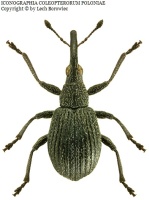Підтримуємо Вільну Україну
 We Support Free Ukraine
We Support Free Ukraine

Biodiversity Map
Taxa

Holotrichapion — subordinate taxa:
Taxon count: 1
-
Arthropodaphylum
Click to switch
to select orders
and filters > -
Hexapodasubphylum
Click to switch
to select orders
and filters > -
Insectaclass
Click to switch
to select orders
and filters > -
Coleopteraorder
Click to set
as the main taxon
and as a base
← of the left panel > -
Polyphagasuborder
Click to set
as the main taxon
and as a base
← of the left panel > -
Cucujiformiaseries
Click to set
as the main taxon
and as a base
← of the left panel > -
Curculionoideasuperfamily
Click to set
as the main taxon
and as a base
← of the left panel > -
Apionidaefamily
Click to set
as the main taxon
and as a base
← of the left panel > -
Apioninaesubfamily
Click to set
as the main taxon
and as a base
← of the left panel > -
Oxystomatinitribe
Click to set
as the main taxon
and as a base
← of the left panel > -
Oxystomatinasubtribe
Click to set
as the main taxon
and as a base
← of the left panel > -
Holotrichapiongenus
Click to set
as the main taxon
and as a base
← of the left panel > -
Holotrichapionsubgenus
Click to set
as the main taxon
and as a base
← of the left panel >
PL
YES
name status: valid name
BioMap ID: 1027152
taxon code: 4944
taxonomy checked: YES
Data on distribution in Poland

Statistics
- Records: 229
- Publications: 78
- Collections: 9
- Publication authors: 52
- Illustrations (iconography): 1
- Photos (specimen/observation): lacking
Taxon description
Gatunek palearktyczny rozprzestrzeniony w Europie od Wysp Brytyjskich, Danii i południowej Szwecji do krajów śródziemnomorskich. W Polsce, choć nie znany jeszcze z niektórych krain, występuje prawdopodobnie na całym obszarze. Występuje na łąkach, miedzach, przydrożach i brzegach lasów. Jako rośliny żywicielskie były wymieniane wilżyna rozłogowa — Ononis repens L., wilżyna bezbronna — O. arvensis L. i wilżyna ciernista — O. spinosa L. Larwy żerują w strączkach nie powodując ich zniekształceń.
Illustrations
... browse
 Holotrichapion
Holotrichapionononis
External data sources
- Ostatnie rekordy
-
1098646
 ×
× Apionidae: Holotrichapion ononis, UA, Skole, Hrebenów, 1934, leg. A. Gottwald, coll. IBL, Zakład Ochrony Lasu, Sękocin: Gottwald
Apionidae: Holotrichapion ononis, UA, Skole, Hrebenów, 1934, leg. A. Gottwald, coll. IBL, Zakład Ochrony Lasu, Sękocin: Gottwald -
1098645
 ×
× Apionidae: Holotrichapion ononis, UA, Skole, Hrebenów, 1934, leg. A. Gottwald, coll. IBL, Zakład Ochrony Lasu, Sękocin: Gottwald
Apionidae: Holotrichapion ononis, UA, Skole, Hrebenów, 1934, leg. A. Gottwald, coll. IBL, Zakład Ochrony Lasu, Sękocin: Gottwald -
1091079
 ×
× Apionidae: Holotrichapion ononis, PL, Gorce, Grywałd, 1981, leg. S. Knutelski
Apionidae: Holotrichapion ononis, PL, Gorce, Grywałd, 1981, leg. S. Knutelski -
1056868
 ×
× Apionidae: Holotrichapion ononis, PL, Beskid Zachodni, Beskid Sądecki, Szczawnik, 1979, leg.
Apionidae: Holotrichapion ononis, PL, Beskid Zachodni, Beskid Sądecki, Szczawnik, 1979, leg. -
987188
 ×
× Apionidae: Holotrichapion ononis, coll. MiIZ PAN: Tenenbaum Sz.
Apionidae: Holotrichapion ononis, coll. MiIZ PAN: Tenenbaum Sz. -
987187
 ×
× Apionidae: Holotrichapion ononis, coll. MiIZ PAN: Tenenbaum Sz.
Apionidae: Holotrichapion ononis, coll. MiIZ PAN: Tenenbaum Sz. -
987186
 ×
× Apionidae: Holotrichapion ononis, coll. MiIZ PAN: Tenenbaum Sz.
Apionidae: Holotrichapion ononis, coll. MiIZ PAN: Tenenbaum Sz. -
987185
 ×
× Apionidae: Holotrichapion ononis, coll. MiIZ PAN: Tenenbaum Sz.
Apionidae: Holotrichapion ononis, coll. MiIZ PAN: Tenenbaum Sz. -
987184
 ×
× Apionidae: Holotrichapion ononis, coll. MiIZ PAN: Tenenbaum Sz.
Apionidae: Holotrichapion ononis, coll. MiIZ PAN: Tenenbaum Sz. -
987183
 ×
× Apionidae: Holotrichapion ononis, coll. MiIZ PAN: Tenenbaum Sz.
Apionidae: Holotrichapion ononis, coll. MiIZ PAN: Tenenbaum Sz. - ... more
- Powiązane publikacje
-
Gosik R. 2006d. Weevils (Curculionoidea) of the middle part of the Bug River Valley. Ann. UMCS, C, 61:7-69.
 Show records
Show records -
Knutelski S. 2005. Różnorodność, ekologia i chorologia ryjkowców rezerwatu biosfery "Tatry" (Coleoptera: Curculionoidea). Monografie Faunistyczne, 23, Wydawnictwa ISEZ PAN, Kraków.
 Show records
Show records -
Petryszak B. 2003. Pędrusie i ryjkowce. [In:] Górecki A., Krzemień K. (Eds.) Przyroda Magurskiego Parku Narodowego. pp. 101-112.
 Show records
Show records -
Mazur M. 2003a. Ryjkowce (Coleoptera: Nemonychidae, Attelabidae, Apionidae, Curculionidae) siedlisk kserotermicznych Polski. II. Szczepanowice koło Miechowa. Wiad. Entomol., 22(3):143-150.
 full text
full text Show records
Show records -
Gosik R., Łętowski J. 2003. Materiały do pozniania ryjkowcowatych (Coleoptera: Curculionoidea) Podlasia. Wiad. Entomol., 22(1):51-52 [336].
 full text
full text Show records
Show records - ... more
- Powiązane zbiory
-
ISEZ PAN
 Show records
Show records -
Kuśka A.*
 Show records
Show records -
MiIZ PAN: Tenenbaum Sz.
 Show records
Show records -
Wanat M.*
 Show records
Show records -
Aleksandrowicz O.
 Show records
Show records - ... more
- Wykaz powiązanych pozycji
-
Curculionoidea of Poland
 Show records
Show records -
Weevils of the Tatra Mts.
 Show records
Show records





